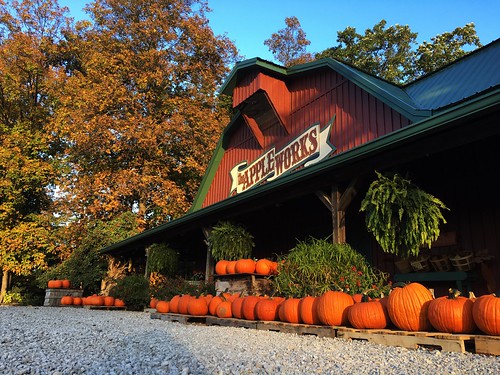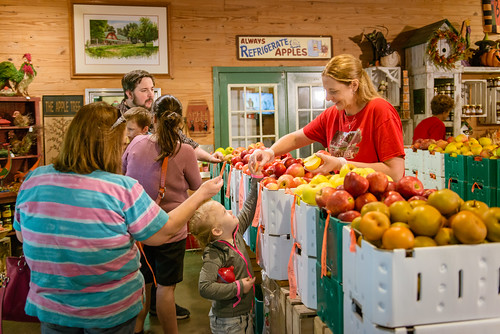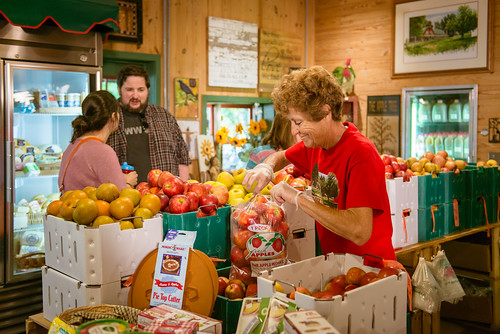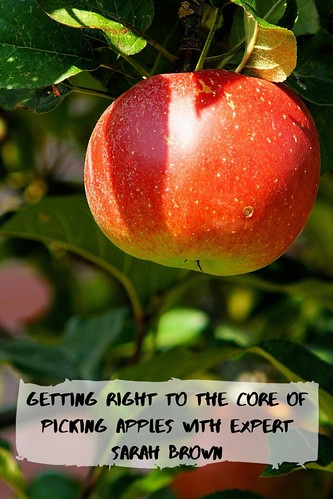Getting Right to the Core of Picking Apples with Expert Sarah Brown
“Everyone can tell you an apple experience,” says Sarah Brown, a touch of nostalgia in her voice. “For me, it was Yellow Transparent. Growing up we had a Yellow Transparent apple tree and I would just sit and eat and eat. Every few hours my mom would come by and say, ‘You’re going to get a tummy ache. You’re going to get a tummy ache.’ But I would stay there for hours, then dusk would come and the sun would turn the crops golden and the fireflies would start coming out.” Sarah remembers the smooth, yellow apples with a juicy, crisp bite and sweet taste even inspired her to pen a poem, “When I was 8 or 10, I wrote a poem about it. About the Yellow Transparent tree,” she laughs.
Apples can be memory makers. And spark memories for people with each crisp bite.

Sarah came to apple growing later in life. She’d had a career as a microbiologist before starting a family and realizing that her passion for gardening had literally blossomed into something more. When a farm went up for sale not far from her home, her husband Rick, suggested that they take a peek. In 1989, they bought their first 10 acres and planted 200 trees. Thirty years later, The Apple Works in Trafalgar, Indiana, boasts 10,000 trees on the 135-acre property, about 25 acres reserved for growing over 70 different varieties of apples.

Photo: The Apple Works
Throughout the world, there are more than 7,500 varieties of apples, whose appeal dates back to the ancient Greeks and Romans. Europeans brought apples to the U.S. (crab apples are the only native apple in North America); today there are about 2,500 varieties. Commercially, 100 varieties are produced in the U.S., which means neighborhood grocers offer only a smattering of apples for the picking.
To truly taste apples in all their varieties, you need to visit an orchard to experience them at the peak of freshness.

Photo: The Apple Works
Here, Sarah explains how to make the most of a visit to an apple orchard, along with some interesting tidbits about picking, storing and cooking apples. She took a break from handpicking Crimson Gala, Swiss Gourmet, Grand Gala, Zestar!, and other apples on her orchard to chat.*
What’s the best way to store apples?
In the refrigerator, always. We also tell people put in a little damp towel in their apple bag to keep them hydrated and so they’ll stay crunchy. Some people put [apples] in their fruit drawers and then put a damp towel over them.
It’s alarming how different varieties story differently. Some apples will last in the refrigerator for months, while others don’t last more than a few days. It all has to do with how much ethylene gas they produce. The more ethylene gas, the faster they ripen. Anything in the Macintosh family just pumps out ethylene gas like crazy.
Other varieties last a long time. Gala apples can be kept for 2-3 months. Fuji apples can be stored for 6 to 7 months. It’s really pretty amazing, it all depends on the variety of the apple.
How do you suggest going about finding the right apples for making pies?
People have their own preferences. Some people like apples in their pie to be al dente; other people like the apples cooked down for a real tender pie. Jonamac make a more tender pie. Goldrush stay firmer.
What I like to do is ask people, “Describe to me your grandmother’s pie. Could you cut it real easily with a fork, or was it crunchier?” I was raised with Yellow Transparent pies. They’d come out almost with an applesauce consistency. I’m partial to that now. Apple pies are kind of sentimental so I try to find the right type of apple to match the kind of pies people are looking for. (For a full list of apple varieties to use in baking see The Apple Works pie chart.)
Any tips on making the most of the apple’s flavor when using them in baking?
I always say the tarter the apple the better the pie. A tart apple can give a pie that wow factor. If you’re using a sweet apple always compensate by using lemon juice. Dip [the apple slices] in lemon juice for tartness.
I’d also suggest using cider instead of sugar where you can for baking so the apple flavor comes through more.
Any tips on making the most of visiting an apple orchard?
Ask questions and try new varieties. We let people sample as many apples as they want. We kind of approach it like wine tasting and that’s an experience that people enjoy. We try to figure out what kind of apples you’ll like and then let people sample. We’ll ask questions like, “Do you prefer a sweet or a tart apple? Crisp or soft? What are you using the apple for – eating or baking?”
Anytime time in September and October you’re going to find some really great apples available. On any given day, we’ll have maybe 24-30 apples at any one time.
What’s your favorite snacking apple?
That’s a hard question. I don’t really have a favorite. I have a lot of apples I enjoy. I personally think Goldrush is wonderful apple. Jonagold is wonderful. Honeycrisp is wonderful, but it’s an ornery apple to grow, very particular.
I also like Ashmead Kernel. It’s an old, antique, heirloom apple that’s super tart. If you put those in cider, then it just adds that kick at the end when you’re drinking it.
Golden Russets have an amazing taste. They have a really rough finish on them and people sometimes avoid them because they think they’re ugly. Then they taste them and say, “Wow, that’s a really good apple.” At the grocery stores you can only buy beautiful apples, but beauty is only skin deep quite literally when it comes to apples.

Photo: The Apple Works
*Edited for length and clarity.
Pin for later:

Kristen J. Gough, a Culinary Spelunker, is the Global Cuisines and Kids Editor for Wandering Educators


















